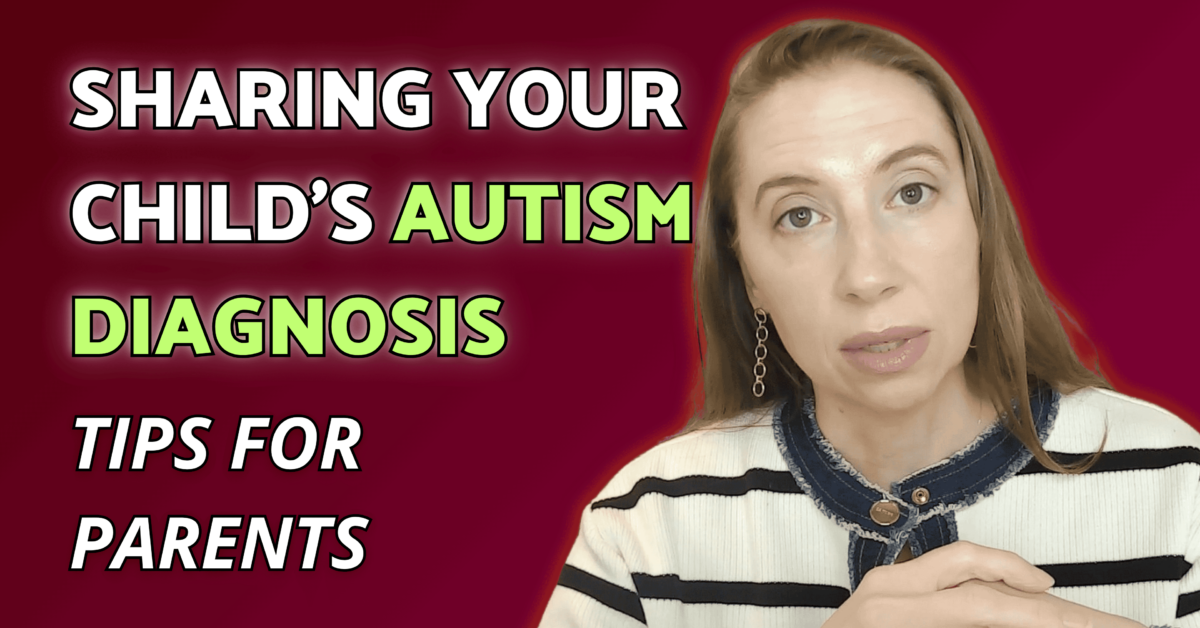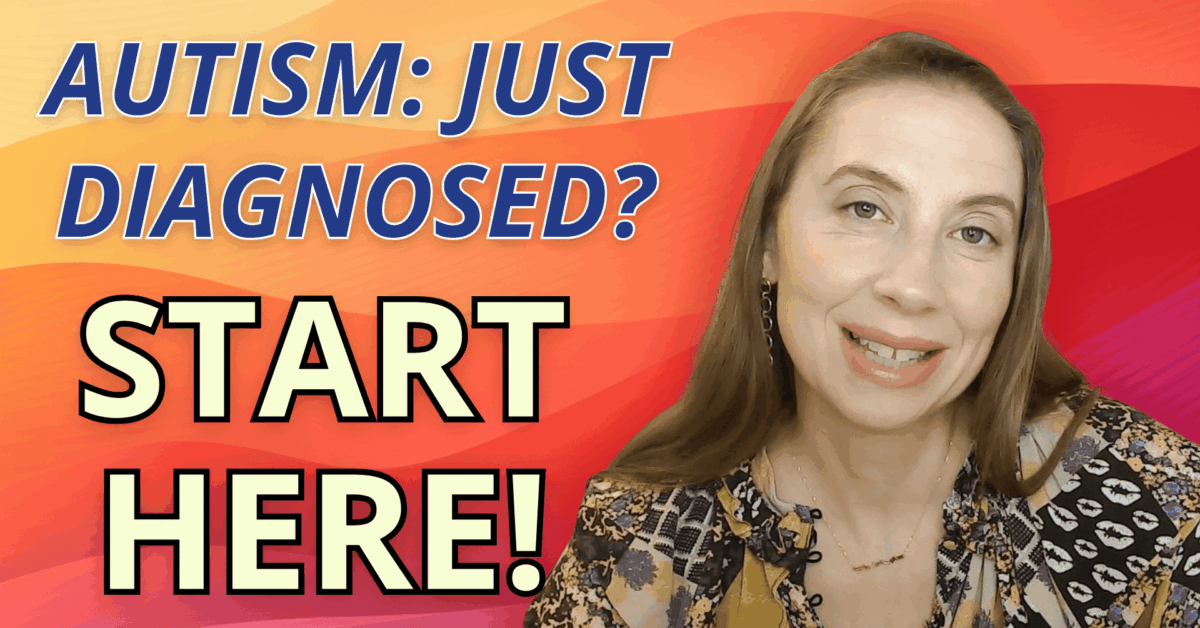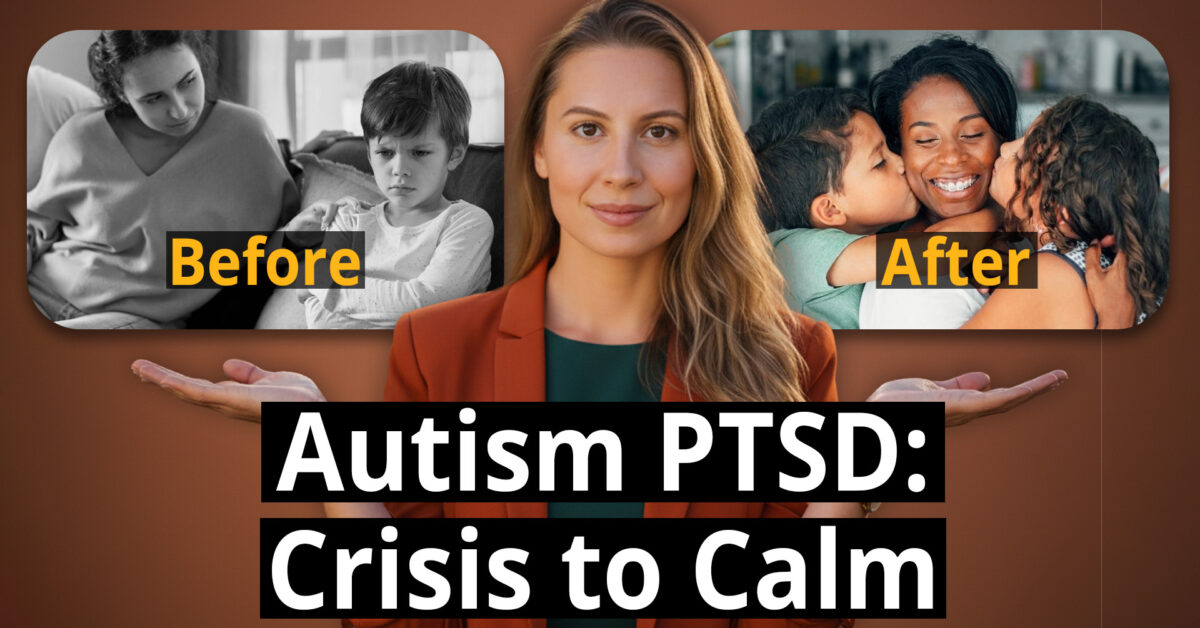If you’re reading this, it probably means someone you love, maybe your child, was recently diagnosed with autism. First, I just want to say, take a breath. You’re not alone.
Today, I want to walk you through one of the hardest but most important early steps, which is telling friends and family about the diagnosis. This can be emotional and confusing and even scary, but it can also be a moment that opens doors to a deeper connection to everyone around you and support. And this is one of the first official times you will begin to advocate for yourself. And for your child.
Confiding can be hard
Why is this step so hard?
- Well, when you’re still processing the diagnosis yourself, it can feel overwhelming to actually explain it to others, especially people who love your child but maybe don’t understand autism.
- Maybe you worry that people judge you or your child.
- Maybe you’re afraid of getting unsolicited advice. That happens a lot.
- Maybe you just don’t want to say it out loud yet because then it becomes real.
All of those thoughts, all of those emotions, that’s the experience of getting a child diagnosed with autism. I’ve talked to hundreds of parents who felt the exact same way, and I felt a whole variety of emotions. Oh, goodness.
When to share
One mom I worked with waited six months before telling her sister, not because she didn’t love her sister, but because she needed the time to understand autism for herself first. Her sister was in the military, and she was very action-focused, and she knew that her sister would be like, “Come on, let’s start doing things!” So the mom just really wanted time to process, figure out a plan. And then she told her sister and got the motivation to execute on the plan that the mom made up herself. And that’s totally fine to do.
Another parent that I work with told their entire extended family the day after the diagnosis. And that’s because she needed the emotional support immediately. They all lived very close to one another. And she also knew that the moment she saw her mom, she would just cry and wouldn’t be able to keep it inside her. So she just wanted to tell everyone. And there’s no one right way. There’s no wrong way to do this. But there are a few things and ways to think about how to do this.
Why do you want to share
So start with your why. Before you say anything, think about why I want to tell this person that my child has autism.
- Do you want help?
- Do you want understanding,
- compassion? Do you want space?
- Do you want encouragement?
- And if your answer is, I don’t know why, then maybe that’s not the right time to tell them.
Once you know your why, the conversation gets easier to have and plan.
Sharing with someone you trust
Let’s say you’re going to share it because it’s someone you trust. You might say,
“Listen, John was just diagnosed with autism, and I’m sharing this because I trust you and I want you to understand what’s going on with us, and some days I’m going to need to vent, and I don’t need you to do anything except listen.”
That tells the person why you’re trusting them and also how they can be helpful. So that’s a great way. It’s like two sentences, a great way to share with someone.
Or you could say,
“John was diagnosed with autism, and we’re still learning what this is and what to do. But I just don’t want to keep this to ourselves. And sometimes I just get so scared and lonely.”
And then you’re leaving the door open for having that conversation.
That person, if they truly care for you, is going to say, “What can I do to help?” So this simple framing helps people realize you’re necessarily not looking for a solution, and you’re really just asking for a connection.
It’s really important to have people around you who you feel are on your team. Maybe they don’t 100% agree with what you’re doing or anything like that. That comes later. But really want to have connections so that you don’t feel so alone and scared. Let’s do some more examples, tailoring how we’re going to tell people.
Sharing with someone who doesn’t know about autism
If you’re telling someone who doesn’t know much about autism, then keep it simple. You might say something like,
“We’ve learned that Mary has autism, and we’re learning what that really means and how best to support her.”
Now you can set the boundary that you want to have. You could say something like,
“If you know a great speech therapist who is maximum 45 minutes away, can you please give me their contact info?”
That would give the person something to do. If you know this person really is going to want to help me. You direct them as to what would be helpful. Or if you don’t want any info from them at all, totally understandable.
When you are overloaded with information
And there are going to be some times where you’re like, “I don’t need any more information coming in.” You could say something like,
“We are overwhelmed with information at this point. So, can we just keep our conversation away from autism topics? I love getting coffee with you and walking with you and talking about this, this, or that, or hearing everything going on with you? Can we just get coffee and just keep off of anything related to autism?”
Totally, right? That’s how you want to set that boundary.
Telling family members
All right, now, if the person is very close to your child, let’s say a grandparent, an aunt, an uncle, something along those lines, you might want to include how they can help, right? You could say something like,
“You’ll probably notice we’re changing how we do certain things here at home since we’ve gotten the autism diagnosis. Now, it’s not about being strict. It’s about helping our daughter feel safe and supported, get healthier, and do whatever their doctor recommended.”
You can get specific there.
Dealing with well-intentioned meddling
But this way, you can have the conversation that your house is going to change. Maybe “we have a swing in the house, and I don’t need to hear anything like, Oh, this is ridiculous to have a swing in the house,” or maybe you’re changing diet, and you don’t want to hear something like, “Oh, can’t they just have a cookie? I mean, a cookie? You’re being so mean to them. They’re a kid, right?”
So you get in front of that by saying,
“It’s not about being strict. It’s about helping our son feel safe and get healthier.”
That’s the conversation that you’re having. So when it is someone who is close and you want to maintain that relationship, you just want to be open with people as to why you’re doing this, and that you’ve thought about this, and this is for the long term.
Dealing with unsolicited advice
Now, for the person who tends to give unsolicited advice, set boundaries lovingly. I’m going to assume that this person is a person you want to have in your life.
Strangers
So, for the strangers who say things, you can feel free to unload some of that anger if you want. If someone’s telling you, a stranger in the supermarket is like, “Oh, why is your kid making so much noise?” They are meaningless in your life. So either walk away, or if you’re having a bad day, you could just say whatever comes to mind and just move on.
Close ones
But if a person you know that you want in your life tends to give you unsolicited advice, you’ve got to set a boundary. So you could say something like,
“I know you care so much about us. Right now, we are following a specific plan.” You might want to tell them what that plan is or not. Totally up to you. So you could then say, “So we may not try every suggestion, but I’m really grateful for your love.”
So this way you’re appreciating them for their love, but you’re also saying, “We don’t need love expressed in that way right now.” You could be firmer. So you could say something like,
“I know you care so much. Right now, we’re following a specific plan. So please don’t send me any info on autism. I’m trying to be very focused. You can certainly save them. And when we need ideas in the future, I will ask you, and we can talk about that. But for right now, I just want to stay really focused and do the plan that we have.”
And then you could also say,
“Right now, I would love to go for a hike with you. Or right now, I would love to go shopping,” or anything.
So it’s not just pushing them away, but you’re setting that boundary of, “All right, this is what we’re doing. I know you love us, and I know you want to share information. So just keep it there. Let me focus. And then what would be really great is if we did…” And hopefully, then that’s where the relationship can continue to grow.
Dealing with denial and unhelpful reactions
All right, now what if their reaction is not supportive? It happens. This is life. We are humans. We have an ideal plan in our mind, and sometimes it doesn’t go that way. So it’s important to understand that not everybody is going to respond well. Some people may be in denial, and other people might say things like, “Are you sure?” We don’t need to hear that. It’s like, “No, we don’t want to be sure. But yes, we are sure.” That question isn’t helpful. Or they might say something like, “Really? They seem totally normal to me. Uncle Bobby used to jump around like that, but he outgrew it. Maybe you shouldn’t worry or stress so much.” And that feels invalidating.
But remember, their reaction says more about their understanding than your child and your parenting. So they might say some of these things out of love. People sometimes just say the wrong thing. I have done that many times, and I’m just like, “Why did I say that?” So they might have that same reaction. But just remember who you are and the great parent that you are.
So if this happens, it’s okay to say something like,
“I understand this might be surprising. We’re really trusting the professionals. I’ve really researched and could explain who you’re actually trusting. And more importantly, we’re seeing our child more clearly than ever. And I really want to make sure that Mary gets what she needs as a child so she can really thrive as an adult.”
Holding your ground
And just know you don’t have to convince everyone. Everyone does not have to agree with what you do. You just need to lead with love and hold your ground.
Learning how to set boundaries is such a foundational part of the parenting autism journey. Oh my goodness, right? You are going to become very, very good at this. You’re going to become a strong advocate. It’s going to feel scary at first, but this is really your first foray into being an advocate. So, consider these first people your first few lessons. Set your boundaries. And if someone is not a meaningful person in your child’s life, make sure that person does not negatively impact you at all.
Quick, practical tips
- So you might want to write out what you want to say. If that helps organize your thoughts, you’re probably very emotional. It’s still a very tender time in your heart. So you might want to write things out so you can organize and maybe even practice with someone.
- If you’re not sure of how a conversation is going to go, practice with a friend whom you have already told.
- Make sure you pick a calm moment. You might not want to do this during dinner, before dinner, or just in a chaotic moment. You really want to have a calm moment. So if there is that conversation, there’s space for it.
- You can certainly use the word autistic or autism diagnosis. There are lots of opinions as to which is the correct one. I don’t think there really is a correct word to use. So, an autistic or autism diagnosis. But when you’re using that word, it really brings clarity to the situation.
- And let them ask questions. You can always say, “I don’t have the answer for that yet.” And that’s totally fine.
A hopeful note
So remember, this is just the beginning. As your understanding grows, so will your confidence. And here’s something beautiful to think about. 37% of children diagnosed with autism eventually lose their diagnosis. That’s not masking, that’s not a misdiagnosis. That means they go on to live life fully with no extra support, just as themselves.
So wherever your child’s journey leads, this moment, this conversation with this person, is not the end. It’s the start of something deeper. You’re building a circle of support. One conversation at a time. And if you want more support like this, consider joining us inside the Navigating Autism platform. Click the link to learn more about working with us.




